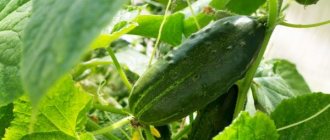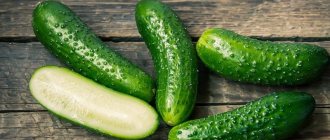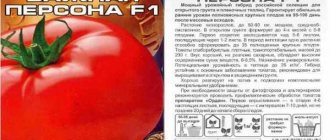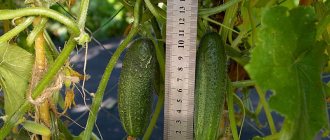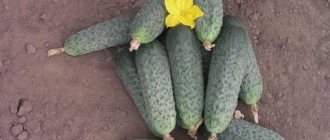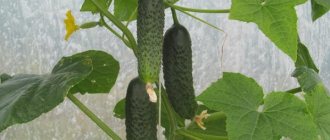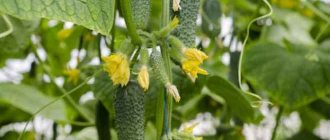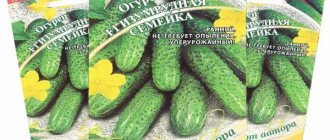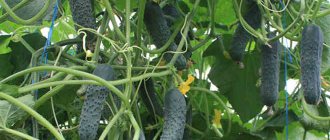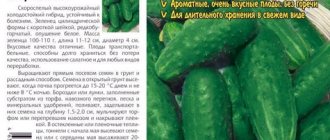Cucumber Patti f1 attracts attention with its relatively short but plump greens with small tubercles. They look great in a salad, and their flavor comes out well when pickled. The hybrid is endowed with all the necessary qualities that allow you to grow a crop without much hassle.
| Landing location | Ripening time | Mode of application | Fruit length | Group | Fruit smoothness | Pollination method |
| Universal | Early ripening (35-45 days) | Universal | Medium - from 10 to 15 cm | Hybrid | Slightly lumpy | Parthenocarpic |
Origin of the cucumber variety "Patti f1"
The Patti F1 cucumber was bred by a group of agricultural breeders in 2004. The hybrid became available to gardeners 4 years later.
It is cultivated in protected soil conditions, on uncovered soil, loggias, and balconies. The plant does not have the ability to self-limit the growth of the main stem. The formation of lateral branches also occurs quite intensively. The leaves are medium in size and grow sparsely on the vine. A cucumber can form up to 8 fruits in one node. Productivity is not tied to pollination by bees.
Zelentsy are approximately the same size. The surface of the vegetable is densely covered with tubercles with prickly light pubescence (see photo). Cucumber can be rich green or just a grassy color. The yellow stripes on the peel are short and blurry.
| Type of growth | long-climbing |
| Branching type | Medium branched |
| Pollination | Parthenocarpic |
| Landing principle | 60x30 cm |
| Fetal parameters | 60-90 g, 10-11 cm, long narrow cylinder, green color |
| According to ripening time | Mid-season (41 – 43 days) |
| Harvest use | Universal |
| Drop off point | Suitable for all types of soil |
| Diseases | Resistant to major diseases of similar crops |
| By type of flowering | Female |
| Yield indicator | up to 25 kg/m2 |
The Patti variety (F1) was bred in 2004 by Moscow agro breeders. In 2008, cucumbers were included in the State Register of Breeding Achievements of the Russian Federation. The main purpose of the variety is cultivation in open ground, under film or in greenhouses.
Description of the hybrid Artist F1
The producer of the hybrid is BEJO ZADEN (Holland), known on the Russian market for high-quality seed products. In 2009, Artist F1 applied for admission; in 2010, he was registered in the State Register catalog. Recommended in all regions of the country, grown on open ground ridges and in film shelters.
The cucumber is valued by amateur gardeners and farmers who grow the hybrid for sale. It is distinguished by good marketable yield, attractive appearance of greens, and suitability for transportation.
Main characteristics
The bushes are powerful, with very strong vines and a well-formed root system. The hybrid belongs to the group of indeterminate cucumbers; the length of the central shoot is not limited (over 2 meters). The plants are vigorous, medium-branched, with large leaves of rich green color.
Note! Artist F1 is a cucumber with predominantly female flowers. In any season, with proper care, a harvest is guaranteed.
At the genetic level, the characteristic of parthenocarpy is laid down, that is, the plant does not require pollination. In the pulp of greens, the seeds almost do not ripen and are in their infancy. Therefore, there is no coarsening of the skin or seed coats, and cucumbers are also not prone to yellowing and overgrowth. Hybrid Artist is a form prone to the bouquet type of ovary formation, but the characteristic appears only with full compliance with agricultural technology and good nutrition. The number of ovaries in the sinuses is no more than 3-4 pieces.
A hybrid of early species, the beginning of harvesting of greens occurs on the 40th day after the appearance of full shoots. Gherkin-type cucumbers, green in color with slight spots and short whitish stripes. The length does not exceed 10 cm, the weight of greens is 90-95 grams. The skin is dense, thick, with large tubercles and thick white pubescence.
The pulp is dense, juicy, there are no seeds or a very small amount (undeveloped). Emptiness and bitterness are absent at the genetic level. White-thorn cucumbers are usually used for salads, but Artist’s greens are suitable for pickling, pickling, and canning. The fruits retain their presentation and taste for a long time and are suitable for long-term transportation.
Advantages and disadvantages
Russian summer residents have been growing the first generation hybrid Artist F1 for almost ten years. Over the years, he has shown himself excellently in various regions of the country. He is valued for the following qualities:
- early release of greens;
- long fruiting period;
- high yields (up to 8.5 kg per square meter in open ground, up to 11 kg per square meter in greenhouses and greenhouses);
- tendency to bunch type of ovary formation;
- resistance to various diseases (viral cucumber mosaic, olive spot);
- parthenocarpy;
- excellent taste of fruits, lack of bitterness in greens;
The hybrid is resistant to temperature changes and is easy to maintain. Shows high collection rates on open ground ridges, in shelters, and in greenhouses. It is characterized by keeping quality and excellent presentation.
One of the disadvantages noted is the high cost of seed material of foreign hybrids. Every year we have to purchase seeds, since the plants of the first generation of hybrids labeled F1 do not retain their parental characteristics.
Description of culture
Hybrid Patti f1 is a self-pollinating crop; pollen transfer for plant propagation occurs independently. This allows the species to be cultivated even in a greenhouse, where access to insects is minimized.
Distinctive features
The hybrid was bred specifically for the Russian climate. It is resistant to temperature fluctuations, prolonged rains, and tolerates dry weather and heat. The fruits set throughout the summer, this period lasts until the first frost.
Patti can be grown on a balcony and loggia; the yield will not suffer at all.
The calorie content of the fruit is 15 kcal per 100 g of product. In cucumbers, 95% is structured water. It is very useful for the human body, as it flushes the kidneys and removes unnecessary toxins, waste and heavy metal salts. The fruits also contain beta-carotene, vitamins A, B1, B2, C, PP.
Patti contains minerals:
- potassium;
- magnesium;
- zinc;
- copper;
- manganese;
- iron;
- iodine;
- chlorine;
- chromium;
- sodium;
- phosphorus.
Frequent consumption of fresh cucumbers has a positive effect on the thyroid gland, prevents the formation of cholesterol plaques on the walls of blood vessels, which serves as an excellent prevention of cardiovascular diseases.
Characteristics
Features of the hybrid fruits are their small size and weight. Patti is a representative of the gherkin type, which is characterized by small fruits up to 10 cm long and 2 cm in diameter. Cucumbers will not grow larger than the genetic size, so there are no barrel-shaped fruits.
The skin of cucumbers is thin and glossy. The color at technical maturity is bright green; there are short and thin light stripes at the top of the fruit. The vegetable is not suitable for long-term storage, since the thin shell does not protect well from moisture loss. The finished harvest should be consumed or processed within 2-3 days.
The pulp is tender, juicy and crispy. The seed chamber occupies up to 2/3 of the cucumber. There are no seeds in its capsules. The taste is high: since the pulp contains sugary substances, its taste is sweet.
The peculiarity of the Patti hybrid is its early ripeness. The first harvest is harvested 1.5 months after sowing the seeds. Mass fruiting occurs 2 weeks from the beginning of cucumber ripening. From 1 m² you get 5–7 kg of fruit.
Advantages and disadvantages
Main benefits of Patti cucumbers (F1):
- Excellent taste;
- No need for pollination by bees;
- High yield;
- When pickling, cucumbers do not create voids;
- Universal use of greens;
- Harmonious ripening of the crop;
- Good transportability;
- Unpretentiousness to growing conditions;
- Persistent immunity to diseases and pests.
The disadvantages of the review variety include:
- The need for constant and abundant watering;
- Capriciousness towards feeding;
- Short shelf life of the crop.
How to grow your own
Growing the Patti hybrid is no different from cultivating other cucumbers.
Growing cucumbers, regardless of the method (seedlings or non-seedlings), begins with the preparation of seed material. It consists of the following:
- Place the seeds in a warm pink solution of potassium permanganate or “Fitosporin” for half an hour, and then place them in a damp cloth.
- Place the planting material in a warm place with a temperature of 30 °C for two days. This time is enough for small sprouts to form.
- Plant the sprouted seeds in loose, fertile soil consisting of humus and garden soil, taken in equal parts.
Planting work is carried out as follows:
- Prepare holes 1-2 cm deep and place seeds in them.
- If you sow seeds for seedlings, first pour the soil into 0.5 liter plastic containers.
- Until the shoots appear, you need to maintain soil moisture in the holes. Young seedlings should be watered as the top layer of soil dries out.
When 4-5 leaves are formed on the plants, the seedlings are transplanted to a permanent place. No more than 4 bushes are placed per 1 m².
When growing Patti cucumbers, you need to follow the following recommendations:
- Plants need regular moisture. Use settled warm water for this. It is especially important to water the bushes during the period of their active growth and development.
- To obtain a rich harvest, it is necessary to apply mineral fertilizers every 10 days. It is better to do this simultaneously with watering.
- Pinching young leaves on the stem will help you get a richer harvest. To do this, the plant is fixed on a trellis, and when the main stem reaches a height of 0.5 m, the lower side shoots, ovaries and inflorescences are removed. In this way, a blinding zone of the bush is formed. Above this zone you will need to pinch the lashes that form on the sides above the first leaf. At a height of 0.5 m, you need to leave 1 ovary and 2-3 leaves.
When growing Patti cucumbers, the following difficulties may arise:
- Yellowing of the leaf. The cause is spider mites and improper watering, when drops of water fall on the foliage and lead to burns.
- Poor growth of young seedlings. The main reason is that the cucumber seedlings are crowded with stronger plants. This can be prevented by removing weeds in a timely manner.
- Weak harvest. This happens for many reasons, for example, untimely watering and fertilization. But most often the problem arises as a result of inept formation of bushes. It is important to regularly remove excess shoots by pinching.
Diseases and pests
Hybrid Patti f1 is resistant to major fungal diseases and is therefore not affected by downy mildew and powdery mildew. Is immune to cucumber mosaic. Plants suffer from root rot only in very rainy and cold summers when grown in dense and airtight soil.
The only pest that can attack cucumbers is the spider mite. Get rid of it by frequent spraying with plain water. Do this in the evening, when there is no sunlight.
New cucumber hybrid Patti
Cucumber is a fairly ancient plant crop that has been used for food for many hundreds of years. Cucumbers differ from other vegetables in that they can be eaten without waiting for them to fully ripen. The greener this vegetable, the more juicy and tasty its pulp will be. But the yellow, large fruits of cucumbers are most often used to put on seeds; they are often not used for food. Cucumber Patti f1, the description of which will be discussed in this article, occupies a worthy place in the suburban area.
Description of the variety
Active cultivation of cucumbers began in ancient times, cucumbers were imported from India to the European part of the world, and since then they have developed throughout our country:
Cucumbers grow well in soils with very different compositions, the main thing is that this soil is moistened and weakens over time. It is important to remember that you do not have to plant cucumbers in one place every year, for this you need to use a new place every year and you can only replant after five years. When growing cucumbers, you should always follow the principles of crop rotation and plant them after corn or tomatoes.
One of the varieties of cucumbers, which is quite popular among summer residents, is the self-pollinating hybrid Patty f1. The main advantage of this variety is that it does not require the help of insects to pollinate it, so it is often chosen for planting in greenhouses where it is quite difficult to provide access to insects. In addition, self-pollinating varieties always produce a much larger yield than other cucumber varieties.
Characteristics of the variety
Distinctive features of the variety:
Cylinder shape with small tubercles.
Color from green to dark green.
The taste of Patty f1 is not bad: it has no bitterness and an attractive crispy taste. Cucumbers of this variety are well resistant to infection by various diseases and tolerate even very unfavorable weather conditions. Patti is one of the varieties characterized by increased fertility.
Features of cultivation
For competent cultivation of Patti cucumbers, it is necessary to plant the seeds for seedlings in the last days of April or early May. To make this process easier, you can plant the seeds in pots filled with a peat mixture. This approach will not only accelerate the growth of seedlings, but also make it easier to plant them in open ground. Patti f1 seeds begin to germinate, maintaining the temperature at thirteen to fifteen degrees. In open ground, this type of cucumber can be planted closer to mid-May to a depth of up to two centimeters.
It is important to cover fresh cucumber crops with plastic film to provide the sprouts with the correct microclimate. Principles of proper cultivation of Patti f1 cucumbers:
- The need for frequent watering: cucumbers of this variety need abundant watering with warm water, especially during their active growth and development.
- Patty f1 cucumbers need to be fed with minerals approximately once every ten days; it makes sense to water them during feeding.
- To increase the yield of cucumbers, you can follow the procedure of pinching young leaves onto the cucumber stem. If the soil is rarely moistened, cucumber fruits may grow bitter.
Patti cucumbers can be used for food approximately forty days after planting. The harvest must be harvested simultaneously in the morning and evening. Do this regularly to prevent overripe fruits, which can collect all the juices from the cucumber stems and prevent new fruits from ripening.
Cucumber beds should always be kept free of weeds
During the first 3 weeks, while the plants are small, loosening is carried out carefully to a depth of 2-4 cm. In the future, loosening should be carried out at least once a week
Watering
During growth and fruit formation, cucumbers need a lot of water. To get maximum yield, water every 6-8 days before flowering and every 3-4 days during fruiting, using warm water. If water does not penetrate well, make a puncture between the rows of plants; such weakening will not disturb the root system of the plant. Under no circumstances should you water cucumbers with a strong stream from a hose; you should only water the soil, not the plants.
Yield varieties: video
You need to harvest regularly, without waiting for the fruits to outgrow. They start doing this in mid-July.
The main purpose of gherkin cucumbers is whole-fruit canning. Small fruits look great assorted or separately. Chopped greens are used to prepare winter salads and canned snacks. Patti is indispensable for fresh consumption.
Young gherkins are very popular with children and adults, which is why they are used in dietary nutrition for certain diseases.
You can make more than just salads from cucumbers. The tender, aromatic pulp is added to okroshka and kuksi.
Patti's cucumbers (F1) are universal in use. Thanks to its tender, juicy, sweetish pulp, the fruits of the hybrid are eaten fresh and also used in the preparation of vegetable salads. Small, regular-shaped cucumbers are ideal for canning, pickling, and pickling. Chopped greens are used to prepare winter salads, canned appetizers, and lecho.
IMPORTANT: Since cucumbers of the review variety are not stored for long, gardeners should decide in advance on the use of the harvested crop.
Variety Patti (F1) has good yield. Subject to the rules of agricultural technology from 1 sq. meters, from 5 to 7 kg of greens are collected. This figure is 20% higher than that of the Druzhina and Zhuravlenok varieties.
The hybrid is intended for cultivation throughout Russia. It is resistant to prolonged rains, temperature fluctuations, and tolerates dry and hot weather well. In the northern regions, Patti cucumbers (F1) produce a good harvest in heated greenhouses.
Agricultural technology or proper cultivation
For cultivation, it is recommended to choose a method: direct planting in beds or seedlings. The latter is more optimal, since you can grow strong, healthy shoots, achieving high yields in the future. Seed material is prepared in late March or April. It is better to choose peat pots or containers filled with fertile crumbly soil.
Note!
Before sowing, the seeds are soaked in a weak solution of potassium permanganate or you can use Fitosporin. Exposure time – 1-2 hours.
To speed up germination, seedlings are installed in a room where normal humidity is stable and the air temperature is not lower than 15 ° C.
It is regularly necessary to spray the planting material with warm, settled water and cover it with plastic film to create a greenhouse effect. The covering is removed after the first shoots appear. For active growth and development, good lighting is installed, and seedlings are sent to the greenhouse in mid-May. When choosing open ground, the prepared sprouts are kept warm until mid-June.
The holes are made 2 cm deep, and the planting pattern is 60x30.
You may be interested in:
To grow a good harvest, you should do the following:
- frequent watering, for which only warm, settled water is suitable;
- regular digging of the soil through loosening, which will improve oxygen access to the root system;
- weeding;
- introduction of organic and nutritious mineral fertilizers intended for melons and melons;
- tying the lashes to the trellis, removing side shoots.
To accelerate the growth and development of plants, sifted wood ash is used, which will bring many benefits. This variety of cucumbers is a sightseeing one, prefers a plentiful amount of moisture, and therefore the lack of frequent and sufficient watering can cause serious consequences. Feeding is applied 2-3 times per season.
Hybrid Patti (F1) is grown by seedlings or by direct planting of seeds in garden beds. However, experienced vegetable growers believe that the seedling method is the most optimal for good plant development and high yield.
Seed material is sown at the end of March or beginning of April. To obtain seedlings, you can use peat pots or containers filled with fertile crumbly soil. Vegetable growers recommend soaking the seeds in a weak solution of manganese or Fitosporin for 1-2 hours before planting.
For better seed germination, the temperature in the room with future seedlings should not fall below 15 degrees Celsius.
Containers with planting material are sprayed with warm water and covered with thin polyethylene. After the sprouts appear, the film is removed. Further growth of seedlings occurs in a well-lit room.
The seedlings are transferred to greenhouses in mid-May, and to unprotected soil in early June.
Plants are planted in holes to a depth of about 2 cm. The recommended planting pattern is 60 x 30.
To create a suitable microclimate in the first days, cucumber plantings are covered with a thin film.
Most often, cucumbers are sown directly into the ground in a greenhouse or on a warm ridge. In such conditions, the harvest can be expected around the end of June. But to obtain even earlier fruits, amateur vegetable growers use the seedling method. When the desired temperature is reached in the greenhouse or garden bed, seedlings are planted in the 4-5 leaf phase, thereby saving approximately 3 weeks during which the cucumber grew.
Those who do not have their own garden often grow Patti on the balcony. The small root system allows you to place the bushes in containers of about 10 liters and get a good harvest.
Growing cucumbers in any way begins with preparing the seeds. Planting material should be soaked in a warm pink solution of potassium permanganate or Fitosporin for 30-40 minutes, and then wrapped in a damp cloth. Place the seeds in a very warm place (30°C) for 1-2 days. During this time, a small sprout (root) will appear on the sharp tip of the grain.
Seeds are planted in holes to a depth of 1-2 cm. If the seeds are sown for seedlings, it is convenient to pour the soil into plastic cups with a capacity of 0.25-0.5 liters. Until seedlings emerge, it is necessary to maintain soil moisture in the holes. Young seedlings are watered as the top layer of soil dries.
To form an “umbrella”, the cucumber is tied to a trellis and all the side shoots of the ovary are removed at the lower 4-5 nodes. At the next 4-5 nodes, the ovaries on the main stem are allowed to grow, but the shoots are removed. The next level of side shoots grows until a bunch of ovaries is formed, and then the vines are pinched off.
Patti is a parthenocarpic cucumber hybrid with a mid-early ripening period. Bred in 2004 by breeders of the Sedek agricultural company (Moscow). Authors of the variety: I.N. Dubinina, M.I. Kirillov and S.V. Dubinin. In 2008, it was added to the state register of breeding achievements of the Russian Federation in the Central Black Earth (Belgorod, Voronezh, Kursk, Lipetsk, Oryol, Tambov regions).
The plants are vigorous, medium-climbing, indeterminate (the growth of the main vine is not limited), with a female flowering type. The leaves are large, dark green. The ovaries in the leaf axils are laid in bunches.
Cucumbers are aligned, cylindrical in shape, short (10 - 11 cm), with small tubercles, weighing 60 - 90 grams. The skin is dark green, with short light stripes. The pubescence is white, high density. The thorns are prickly. The pulp is tasty, tender, crispy, sweetish. Medium sized seed chambers. The yield of marketable fruits is 115 - 370 c/ha, which is 22 - 43 c/ha higher than that of the standard varieties Druzhina and Zhuravlenok. The fruits do not last long.
Variety of universal use. Thanks to the small size of the fruits, it is excellent for harvesting for the winter. No voids are formed during canning.
The advantages of the Patti cucumber: complex resistance to diseases and stressful conditions, excellent taste, friendly and abundant harvests, high marketability and transportability, one-dimensionality of the fruit.
This hybrid produces a high yield even in bad weather conditions and is especially popular among gardeners, as evidenced by many positive reviews.
Cucumber can be planted using seedlings or without seedlings. Regardless of the method chosen, the following must be considered:
- the depth of sowing seeds in the ground is less than 2 cm;
- When planting seedlings or direct sowing, the soil should warm up to 13 - 15 degrees;
- soil suitable for the plant – light, well fertilized;
- seedlings are considered viable after the formation of 4 - 5 leaves;
- in open soil, cucumbers are placed at a density of 4 - 5 bushes per 1 m2, in a greenhouse - up to 3 bushes per 1 m2;
- up to the level of 5 nodes the culture is blinded;
- The cucumber is fed every 10 days.
Sowing seeds for seedlings | Planting seedlings in a greenhouse/greenhouse | Planting seedlings in exhaust gas | Stepsoning | Harvesting (in the greenhouse / in the greenhouse) |
| Last days of April – beginning of May | May | From late May to early June | Blinding the first 4 nodes followed by pinching the side shoots | From June |
| *dates are indicated for central Russia | ||||
1. Seedlings. To obtain high-quality seedlings, you need to start sowing cucumbers at the end of April. To simplify the process, you need to use seedling cups, filling them with special soil.
This method of growing seedlings will significantly facilitate their planting for permanent residence, and will also accelerate their growth. The seeds of this hybrid germinate at a temperature of 13-15 degrees.
2. Planting seedlings. You can plant the plant in the ground as early as the 15th of May. To do this, prepare holes up to two cm deep.
3. Growing cucumbers. An important step in caring for these plants is timely watering. Cucumbers should be watered exclusively with warm water, especially during the period of growth and fruiting.
Plants are fed with mineral fertilizers approximately once every 10 days.
Also, to increase the yield, if necessary, perform the procedure of pinching young leaves to the stem of the plant.
A worthy, prolific guest on the site is the Patti f1 cucumber: description of the variety
Cucumber Patti f1 attracts attention with its relatively short but plump greens with small tubercles. They look great in a salad, their taste is well revealed when pickled.
The hybrid is endowed with all the necessary qualities that allow you to grow a crop without much hassle.
| Landing location | Ripening time | Mode of application | Fruit length | Group | Fruit smoothness | Pollination method |
| Universal | Early ripening (35-45 days) | Universal | Medium – from 10 to 15 cm | Hybrid | Slightly lumpy | Parthenocarpic |
Description and characteristics of the variety
The hybrid variety Patti f1 was created by specialists (Moscow) in 2004. It can be grown in open or closed ground, as well as on loggias and window sills. Thanks to parthenocarpy, the plant sets fruit without requiring pollination by insects.
Characteristics of the bushes: indeterminate type, with long shoots. The branches are medium, the leaves are not very large. The fruits are set in bunches and ripen on the 40-45th day after the sprouts appear.
Description of the fruits: cucumbers reach 10-11 cm in length, they are all the same size, aligned. Fruit weight is 60-90 g. Tiny tubercles are densely located on the dark green skin, the pubescence is white. The seed chambers are small and contain few seeds.
The pulp has a sweetish taste, juicy, crispy, very tasty. There is no bitterness. The hybrid is suitable for harvesting and fresh consumption.
Advantages and disadvantages
- great taste;
- excellent presentation;
- high productivity;
- rapid ripening;
- self-pollinating;
- long fruiting period;
- good transportability;
- resistance to stress;
- good resistance to major diseases.
Minuses:
- not very long shelf life;
- impossibility of harvesting seeds.
Landing
In the middle zone, they begin planting gherkin seeds for seedlings in April. Sow at the beginning of April if you plan to plant in a greenhouse, at the end - for open ground. Seeds can be sown in the garden bed when the soil temperature reaches +14-15 degrees, in the middle zone this is the second half of May or the beginning of June. In the southern regions, procedures are carried out 2 weeks earlier.
Hybrid seeds are processed before packaging. But if you purchased seeds without a colored shell, you can pickle them in a 1% solution of potassium permanganate for half an hour, and then rinse and place them in a growth stimulator solution for the same period.
Plant the seedlings in small peat pots filled with nutrient substrate:
- 1 part of turf land;
- 1 part peat;
- 0.5 or 1 part drainage (sand, vermiculite or sawdust);
- 2 parts humus.
Planting depth is 1.5-2 cm. Moistened containers are kept warm until germination, then the temperature is reduced. Seedlings are grown in the sunny part of the apartment for 25 days. You can feed it once with complex fertilizer.
For sowing into a garden bed or transplanting seedlings there, it is prepared in the fall. An area on a hill, protected from the wind, is dug up and organic fertilizers are applied. If necessary, reduce acidity if the soil pH is above 6-7. To do this, add dolomite flour, slaked lime, ash or chalk.
For 1 sq. m in open ground, 4-5 bushes are placed, and in a greenhouse, 2-3.
Growing and care
Cucumbers are watered generously, but not excessively. The roots extend close to the surface of the soil, so it should not be allowed to dry out. Use warm water when caring, watering is carried out depending on the weather daily or 2-3 times a week.
Feed three times per season with an interval of 10-14 days. Fertilizing is combined with watering. Mineral fertilizers, manure, and bird droppings are added to the water. It is necessary to alternate organic products with mineral ones, otherwise the cucumbers will not receive balanced nutrition.
To increase productivity, bushes are formed by cutting off excess lower shoots. The crops are harvested as often as possible.
Care
Basic rules for caring for Patti cucumbers (F1):
- Frequent watering with warm and settled water;
- Regular loosening of the soil in an area with plants;
- Weeding beds from weeds;
REFERENCE: Feeding bushes with sifted wood ash will have a positive effect on yield.
- Feeding bushes with organic fertilizers and nutritional mineral complexes.
Plants of the review variety are very moisture-loving, so they need frequent and regular watering. Cucumbers are fed 2-3 times per season with complex mineral fertilizers intended for melons and melons.
Patti cucumbers (F1) need to be tied to a trellis and the lower side shoots removed.
General characteristics of the plant
Fruit set throughout the summer until the first frost. It is permissible to grow it on a balcony or loggia, which will not negatively affect the yield of the plant. The peculiarity of the fruits is that they are small in size and weight. Patty is a representative of the gherkin type, the characteristic features of which are considered to be:
- length up to 10 cm;
- diameter up to 2 cm.
Cucumbers will not grow larger in size than what is in the genes even with the most proper care, and therefore the formation of barrel-shaped fruits is excluded. The skin is thin with a glossy surface. The cucumber has:
- bright green color when reaching technical maturity;
- short and thin light green stripes at the tip;
- soft, tender, juicy, crispy pulp;
- a seed chamber, the size of which is 2/3 of a cucumber, but there are no seeds in the capsules;
- excellent taste.
Due to the delicate shell, the variety has a too short shelf life, and therefore the finished harvest must be processed or consumed within 2-3 days.
Note!
Many people value Patti for its early ripeness, since the first harvest can be harvested 30-45 days after sowing the seeds.
Fruiting is massive and begins 2 weeks after ripening. From 1 m2 of planting you can harvest about 5-7 kg of crop.
The advantages are:
- taste;
- high level of productivity;
- the absence of voids in the cucumbers that can form during pickling;
- versatility;
- amicable maturation;
- resistance to transportation;
- unpretentiousness;
- resistance to diseases and pests.
Among the negative qualities are the need for regular, abundant watering, capriciousness regarding fertilizing, since the dosage, application period, and short shelf life must be carefully observed.
The variety is medium-climbing, with unlimited growth of the main shoot. In greenhouse conditions, the vine must be tied up and shaped like an “umbrella” in order to get a larger number of greens per 1 m². In open ground, gardeners act differently: the vines are left to spread along the soil, but to get a large harvest, they pinch the main stem above 4-5 leaves, getting 3-4 shoots from 1 root.
Hybrid cucumber Patti F1 was created specifically for the Russian climate. It is resistant to temperature fluctuations in the summer, prolonged rains, and tolerates hot, dry weather well. The fruits set throughout the summer, until the first frost. The hybrid is parthenocarpic and does not require pollination by bees.
The variety is resistant to most fungal diseases and is not affected by powdery mildew and downy mildew. Is immune to cucumber mosaic. It can suffer from root rot in summers that are too rainy and cold when grown on dense, air-tight soil.
In the Patti cucumber hybrid, the description given by gardeners particularly emphasizes its early ripeness. The first cucumbers begin to appear 1.5 months after sowing the seeds. Mass fruiting occurs after another 2 weeks. The total yield reaches 5-7 kg per 1 m², and in 1 harvest you can harvest 0.5 kg of greens from the same area.
Cucumber Patti F1
To increase productivity, I start seeding long before placing it in the ground. I grow it in a ready-made peat mixture at a temperature of 13-15 degrees. If it is warmer, the plants may not take root when picking. Before the seedlings take root normally and take root well, I keep them under a film cover. The seeds should not be buried too deep, otherwise they will not germinate. With standard care procedures, the taste of the fruit is good. With insufficient watering, cucumbers may turn yellow, but bitterness does not appear. Resistance to most “cucumber” diseases is high, but periodic protection from pests is required.
The variety is highly productive. Ripe cucumbers are small in size and have dark emerald skin; they grow on the bush in clusters (up to 8 pieces in one node). The length can reach 10 cm, but the weight does not exceed 70 grams. A crop of approximately the same size is formed. The skin is quite dense, with a large number of tubercles and spines. During long-term transportation, the fruits do not suffer. Greenhouse cultivation occurs without problems; the formation of a large number of ovaries occurs without the participation of pollinating insects. In order for the seedlings to take root well and become strong, I grow them in a special peat mixture. The optimal picking time is mid-May. It is necessary that the soil warms up well
Patti is prone to bitterness, so great attention must be paid to frequent and abundant watering.
It is important that the soil is always well moistened. Immunity to infectious and fungal diseases is genetically high
With excessive watering, root rot does not develop. The harvested crop has a short shelf life; within a few days it must either be processed or eaten. There are no other difficulties with growing the variety; even novice gardeners can cope
Immunity to infectious and fungal diseases is genetically high. With excessive watering, root rot does not develop. The harvested crop has a short shelf life; within a few days it must either be processed or eaten. There are no other difficulties with growing the variety; even novice gardeners can cope.
Diseases and pests
The hybrid is highly resistant to most fungi and is not affected by peronospora and powdery mildew. Plants are immune to cucumber mosaic. Cucumbers can be affected by root rot when grown in dense, airtight soil under rainy, cold summer conditions.
In open ground, plantings of bushes can be harmed by:
- Slugs;
- Aphid;
- Spider mite.
When insects or gastropods appear, folk recipes or special insecticidal preparations are used.
Pollination and immunity
This hybrid is self-pollinating. Pollen is transferred to the plant on its own, and therefore there are no problems with reproduction and maturation. Cultivation of the species can be done even in a greenhouse or at home, where there is practically no access to insects.
When planted in open ground, bushes can be damaged by slugs, aphids, and spider mites. As soon as the first signs of the presence of such pests are detected, treatment of gastropods should begin using folk recipes and industrial insecticides. You must follow the instructions for use so as not to destroy either the seedlings or the harvest.
Description of fruits
The characteristics of the greens that gardeners provide include the small size and weight of the fruit. Hybrid Patti belongs to the gherkin type varieties, i.e. it forms small fruits, up to 10 cm long and 2 cm in diameter. Cucumbers have a regular cylindrical shape and retain it even when somewhat overripe.
The skin is thin and shiny. The color at technical ripeness is rich green, with short and thin light stripes at the tip of the fruit. The fruits cannot be stored for a long time, because the shell does not protect them well from moisture loss. It is advisable to consume or process cucumbers within 2-3 days.
The flesh is tender, juicy, crispy, but not too hard. The seed chamber occupies up to 2/3 of the diameter of the fruit. Its capsules remain empty and do not contain seeds. Reviews about the taste are high: the pulp contains sugary substances, so it tastes sweet. Cucumbers do not produce cucurbitin, which gives the fruit a bitter taste.
The main purpose of gherkin varieties is whole-fruit canning. Small cucumbers look great assorted or separately. They can be pickled or salted without vinegar. Slightly overgrown fruits make delicious pickles. Chopped greens are also used for preparing winter salads and canned snacks, and are included in lecho.
As one of the early varieties, Patti is indispensable for fresh consumption. Young sweet cucumbers are popular with children and adults and can be recommended as a dietary food for certain diseases. They contain a lot of potassium, which helps remove water from the body and reduce swelling. Cucumber dishes are not just salads. The delicate, aromatic pulp is included in okroshka and kuksi; cucumber slices complement hamburgers and sandwiches, delicacy rolls and buffet canapés.
